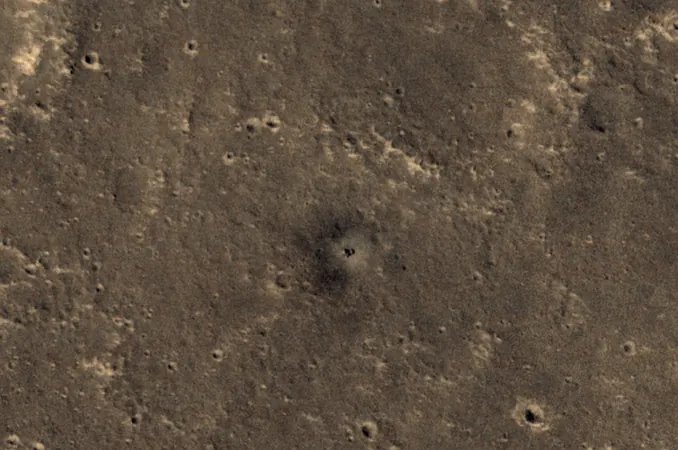
NASA’s InSight Lander: A Silent Sentinel of Martian Secrets After Two Years of Dormancy
2025-01-05
Author: Mei
Overview of InSight's Mission
NASA’s Mars Reconnaissance Orbiter (MRO) has recently captured stunning images of the InSight lander, which has been dormant on the surface of Mars for two years. The observation reveals intriguing movements of Martian dust around the lander, providing valuable insights into the Red Planet's climate and atmospheric conditions.
InSight's Operational Phase
InSight, which stands for Interior Exploration using Seismic Investigations, Geodesy, and Heat Transport, landed on Mars on November 26, 2018, in the vast Elysium Planitia region after an arduous seven-month journey through space. During its operational phase, the mission focused on monitoring seismic activity, measuring the Martian internal heat transfer, and creating detailed models of Mars' interior. Its groundbreaking discoveries contributed significantly to our understanding of Mars but faced eventual challenges, primarily due to dust accumulation on its solar panels, leading to a decline in power and the conclusion of its mission.
Challenges of the Martian Environment
The Martian environment presents unique challenges. The persistent winds and weather patterns contribute to frequent small dust storms that coat the InSight lander and its surroundings. While the mission was active, InSight's onboard cameras, in collaboration with MRO's powerful High-Resolution Imaging Science Experiment (HiRISE) camera, were utilized to assess the dust levels on the solar panels. However, with the mission now concluded, InSight can no longer assist in this monitoring, placing greater importance on MRO’s continued observations.
Ongoing Research and Discoveries
Ingrid Daubar, a member of the InSight team from Brown University, emphasized the ongoing importance of monitoring dust collection around the lander: 'Even though we’re no longer hearing from InSight, it continues to teach us about Mars. By tracking how dust accumulates and how wind and dust devils redistribute it, we gain insights into the wind-dust cycle and other processes shaping the planet.'
Dust Devils and Their Impact
Dust devils, swirling columns of air common on Mars, frequently traverse the surface, often dislodging dust that covers landers and rovers. These phenomena have been the subject of extensive research, as understanding their behavior is crucial for future missions to Mars—especially since Martian dust can potentially interfere with the functioning of spacecraft components.
MRO Observations and Conclusions
Recent images from MRO highlight numerous tracks created by dust devils around InSight. During its operational state, scientists noted the prevalence of these dust devils, particularly during Martian summer, and their conspicuous absence in winter. Furthermore, MRO's observations have facilitated analyses of meteoroid impacts on the planet, revealing that regions with higher crater density represent the oldest geological areas of Mars—unlike Earth, where constant tectonic activity erases such evidence.
The Memory of InSight
The dynamic Martian atmosphere means that some craters can become obscured as dust accumulates around their rims, complicating age determination. Interestingly, the craters created by InSight’s landing thrusters initially appeared dark brown but have returned to the distinctive red-brown hue typical of the Martian terrain due to dust movements, providing a live case study on the dust covering process.
Bittersweet Reflections
Looking back on the InSight mission, Daubar expressed a blend of emotions: 'It feels a little bittersweet to look at InSight now. It was a successful mission that produced a wealth of scientific knowledge. While we wished for it to last indefinitely, we understood that this wouldn't be feasible.'
Future of InSight and NASA's Hopes
Despite the InSight lander going silent, NASA engineers remain hopeful that a dust devil might sweep through, clearing the solar panels and allowing for one last recharge and potential signals from the spacecraft. However, after two years without communication, NASA has set a deadline to cease listening for signals from InSight at the end of 2024.
Conclusion and Legacy
As we draw near to this significant farewell, the MRO's most recent HiRISE imagery serves as a final tribute to InSight's contributions to our understanding of Martian geology. For decades to come, the historic lander will stand as a silent monument, preserving the secrets of the Martian landscape. Stay tuned as we continue to uncover the mysteries of the Red Planet—who knows what discoveries await us on Mars?
 Brasil (PT)
Brasil (PT)
 Canada (EN)
Canada (EN)
 Chile (ES)
Chile (ES)
 Česko (CS)
Česko (CS)
 대한민국 (KO)
대한민국 (KO)
 España (ES)
España (ES)
 France (FR)
France (FR)
 Hong Kong (EN)
Hong Kong (EN)
 Italia (IT)
Italia (IT)
 日本 (JA)
日本 (JA)
 Magyarország (HU)
Magyarország (HU)
 Norge (NO)
Norge (NO)
 Polska (PL)
Polska (PL)
 Schweiz (DE)
Schweiz (DE)
 Singapore (EN)
Singapore (EN)
 Sverige (SV)
Sverige (SV)
 Suomi (FI)
Suomi (FI)
 Türkiye (TR)
Türkiye (TR)
 الإمارات العربية المتحدة (AR)
الإمارات العربية المتحدة (AR)